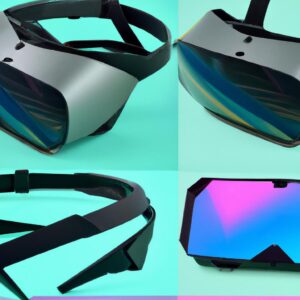Introduction: Virtual and Augmented Reality Headsets
Virtual Reality (VR) and Augmented Reality (AR) headsets are becoming more and more popular with gamers due to their immersive gaming experience. VR headsets completely immerse a user in a fully computer-generated environment, while AR headsets allow for virtual objects to be “displayed” onto real-life surroundings. It is important to understand the differences between the different headsets available today, including standalone devices, smartphone-powered headsets, and VR headsets for gaming consoles.
Every type of headset has its own advantages and disadvantages, and it’s important to research the features and specifications of each headset before making a purchase. This guide will cover all of the different types of virtual and augmented reality headsets available today, highlighting their differences and analyzing their cost-effectiveness.
Advantages and Disadvantages of Different Headsets
Virtual Reality (VR) and Augmented Reality (AR) headsets come in many shapes and sizes, each with their own unique advantages and disadvantages. Standalone headsets are self-contained and don’t require additional hardware, whereas smartphone-powered headsets allow you to pair a special headset with your smartphone for use in VR or AR. Both types of headsets have their own pros and cons that should be considered when deciding which one to purchase.
Standalone headsets often come with higher quality displays, more powerful sensors, and greater accuracy for tracking a user’s head movements. The downside is that they are larger, more complicated, and cost considerably more than smartphone-powered headsets. On the other hand, smartphone-powered headsets are designed for convenience and portability. These headsets are smaller, lighter, and generally cheaper than standalone headsets. However, these headsets usually come with lower quality displays and sensors that may not track the user’s movements quite as accurately.
Comparing Standalone Headsets and Smartphone-Powered Headsets
When it comes to VR and AR headsets, there are two major types: standalone and smartphone-powered. Standalone headsets are self-contained devices that come with all the necessary hardware to run the headset. These are typically the more powerful option and have higher quality visuals and sound. Smartphone-powered headsets are exactly what they sound like – they use your smartphone as the base hardware for the headset itself. While this type of headset is usually cheaper, it doesn’t offer the same quality visuals or sound as a standalone headset.
Standalone headsets typically offer more control options, as well as more processing power. This means they can handle more complicated games and applications. However, they tend to be more expensive than their smartphone-powered counterparts. Smartphone-powered headsets, on the other hand, are usually less expensive but offer less control and less power. They are also often limited in the types of games and applications they can offer, as they rely on your smartphone for the majority of the processing power.
When deciding between the two types of headsets, it is important to consider your budget and what type of gaming experience you are looking for. If you are on a tight budget, then a smartphone-powered headset could be a great option. However, if you are looking for a more immersive gaming experience, then a standalone headset is probably the way to go.
Highlighting Specific Features and Specifications for Each Type of Headset
When considering which type of headset is right for you, it is important to understand the features and specifications of each model. Standalone headsets, smartphone-powered headsets, Playstation VR, and Xbox VR each offer a range of features and functionality that can help you make the best decision for your needs.
- Standalone Headsets: Standalone headsets provide the most comprehensive virtual reality and augmented reality experience, with powerful processors and graphics chips designed to deliver highly immersive experiences. Standalone headsets are often wireless and capable of tracking head and body movements accurately. They are typically more expensive than other types of headsets, but they offer the most advanced features.
- Smartphone-Powered Headsets: These headsets use a smartphone or tablet to provide the display and computing power for the user. They take advantage of a device’s existing processors, graphics chips, and battery life, making them more affordable than standalone headsets. Smartphone-powered headsets can provide a range of immersive experiences, though not as powerful or comprehensive as those offered by standalone headsets.
- Playstation VR and Xbox VR: Both Sony and Microsoft have developed their own virtual reality headsets for use with their gaming consoles. These headsets offer highly immersive gaming experiences for users who already own the gaming systems. Playstation VR and Xbox VR headsets can be connected to the console via a USB cable, and provide an enjoyable and affordable virtual reality experience.
Headsets for Gameplay, Video, Audio, and More
One of the most important features of virtual reality (VR) and augmented reality (AR) headsets is the way they allow us to experience games, videos, audio, and a variety of applications in unique ways. Whether you’re playing a virtual reality game or streaming a 360-degree video, each type of headset offers a different level of immersion and interactivity.
For instance, standalone VR headsets are the most advanced headsets available today. They create a fully immersive experience with no reliance on an external device, while smartphone-powered headsets are an affordable way to get into VR and AR without sacrificing the quality of the experience. Both types of headsets allow for a variety of applications like gaming, experiencing 360-degree videos, watching movies in 3D, listening to music, and more.
- Standalone headsets provide the most immersive experience with no reliance on an external device.
- Smartphone-powered headsets are an affordable way to get into VR and AR.
- Both types of headsets allow for gaming, 3D movies, 360-degree videos, and more.
Examining PlayStation VR and Microsoft Xbox VR Headsets
When it comes to virtual reality and augmented reality headsets, two of the most popular brands are the PlayStation VR from Sony and Microsoft’s Xbox VR. Both offer users the chance to immerse themselves in interactive virtual worlds and play video games with a level of realism that was previously unimaginable. But there are different pros and cons to each type of headset.
The PlayStation VR offers an expansive library of games, including titles from some of the most popular franchises like Resident Evil and Final Fantasy. Its visuals are also among the most impressive available for any VR system, and its built-in social features help users stay connected with friends who are also playing. On the downside, the PlayStation VR can be more expensive than other headsets, and its limited battery life can be an issue for gamers who want to spend extended periods of time playing.
Microsoft’s Xbox VR headset has a few advantages over the PlayStation VR as well. It is slightly less expensive but still offers access to a wide range of games. Its integrated tracking technology makes it easier to move around virtual environments and its wireless connection to the Xbox console eliminates cumbersome wires. However, the Xbox VR does have somewhat lower resolution than the PlayStation VR, and its battery life is also shorter.
Analyzing Popularity of Different Types of Headsets Among Gamers
It’s no surprise that virtual reality (VR) and augmented reality (AR) headsets are becoming increasingly popular among gamers. According to a survey, VR and AR headsets account for 11% of the total gaming revenue in 2020, and this number is projected to grow in the coming years. It’s evident that these headsets are making a big impact on the gaming industry.
But which type of headset is the most popular among gamers? It’s difficult to pinpoint one specific headset as the most popular among all gamers. While some gamers prefer standalone headsets, others are more interested in smartphone-powered devices. Playstation VR and Microsoft Xbox headsets have their own dedicated fan following. Ultimately, it depends on the individual gamer’s preference.
Although it’s difficult to pick one specific headset, we can look at the general popularity of different types of headsets. Standalone headsets offer full immersion into VR environments, but they tend to be more expensive than smartphone-powered devices. On the other hand, smartphone-powered headsets provide decent compatibility and affordability at the cost of fewer features. Additionally, Playstation VR and Microsoft Xbox headsets focus on providing a great gaming experience but come with proprietary controllers.
Therefore, there’s no one type of headset that could be considered the “most popular” among gamers. It’s essential to research each type and weigh their respective advantages and disadvantages before making a decision.
Cost and Performance of Headsets
When it comes to VR and AR headsets, cost is often a major consideration. Thankfully, there is now a wide variety of options available at different price points to suit users of all means. Performance-wise, the headsets are surprisingly efficient and offer an immersive experience. However, there are certain factors that one needs to consider before investing in a headset.
The cost of VR and AR headsets can range from a few hundred dollars to several thousand dollars. The higher-end models offer better performance and features, but you must keep in mind your budget and the type of experience you want. If you are looking for something more basic, then the lower-end models may be suitable for you. But if you are interested in the latest technology and features, then you may need to invest in the more expensive models.
Price-to-performance ratios of various headsets need to be considered too. Some models may be pricey, but provide great value for money because of their specs and features. Similarly, there are cheaper models that offer decent performance but should be used only if you are on a tight budget. It is important to do the research required to find out which model offers the best value depending on your specific needs.
Headgear Accessories for Headsets
Using a headset with the correct headgear can help you enjoy your VR or AR experience to the fullest. It is important to learn about the variety of headgear accessories available for all types of headsets so that you can choose the one that suits your needs the best.
There are numerous headgear designs and sizes available to suit everyone’s needs. Some of the most popular are:
- Full-face helmets: These provide maximum protection and comfort. The design covers the entire face and head, and most models come with adjustable straps for a snug fit.
- Lightweight headsets: These are designed to be lightweight and comfortable yet still provide a clear view of your VR or AR environment.
- Wireless headsets: These allow you to move around freely without having to worry about cables becoming tangled or loose. Wireless headsets are usually battery-powered and provide quality visuals and audio.
- Bluetooth headsets: These headsets use Bluetooth technology to connect to your computer or device, eliminating the need for wires and making them incredibly convenient for gaming or watching videos.
- Noise-cancelling headsets: These headsets help cancel out background noise and ensure a comfortable experience without distractions.
It is important to remember that every person is different, so the best type of headset and headgear will depend on individual needs and preferences.
Analyzing Alternative Uses for Different Types of Headsets
Virtual reality (VR) and augmented reality (AR) headsets are becoming increasingly popular in the gaming world. However, they can be used for far more than just playing video games. With their advanced technology, VR and AR headsets provide a wide range of different functions and possibilities.
For example, one of the most interesting uses is for viewing and interacting with 3D content. This could include anything from movies or television shows to creating artwork or exploring new worlds. There are also many educational uses for these types of headsets, such as providing virtual tours of museums or interactively learning about history.
VR and AR headsets can also be used for medical purposes, such as helping surgeons conduct operations and enabling them to practice complex procedures. They are also useful for physical rehabilitation, as they can help people improve their coordination and balance. Finally, they can be used for therapeutic purposes, providing an immersive environment that helps people escape from the stresses of everyday life.
In addition to these alternative uses, VR and AR headsets can provide entertainment experiences that are unlike anything offered by traditional media. Users can explore virtual worlds, engage in multiplayer challenges, and compete in tournaments against other players around the world. As the technology continues to advance, the range of possibilities will only expand.
Summary of the Different Types of VR and AR Headsets Available Today
Virtual Reality (VR) and Augmented Reality (AR) headsets have seen a surge in popularity in recent years with the advent of technology developments. There are a variety of headsets on the market today that differ depending on their functionality, features, affordability, and the applications they can be used for.
Standalone headsets, such as the Oculus Quest 2, are self-contained and come with pre-installed hardware, allowing them to be used independent of other devices. Smartphone-powered headsets, on the other hand, such as the Samsung Gear VR or Google Cardboard, require a compatible smartphone to power the display and other functions.
Playstation VR and Microsoft Xbox VR headsets offer an immersive VR experience specifically tailored to gaming. Each one provides unique features and specifications, as well as various accessories that further enhance the experience. Additionally, both types of headset come with their own pros and cons when compared to one another.
The cost of headsets varies depending on which type is being purchased. It is important to consider the price-to-performance ratio when selecting a headset as this will ultimately determine how much value it provides for your money.
Finally, VR and AR headsets can be used for a variety of applications, ranging from gaming to video, audio, and more. While gaming remains the primary use case, headsets can also be used for other purposes, such as educational experiences or training simulations.
Conclusion – What Are the Different Types of VR and AR Headsets Available Today?
In conclusion, consumers now have a variety of different options when it comes to selecting the right type of virtual and augmented reality headset. Standalone headsets offer a more immersive experience with high-end visuals and audio, while smartphone powered headsets provide a more affordable solution and do not require additional hardware. PlayStation VR and Microsoft Xbox VR headsets are popular among gamers thanks to their specifications and performance. Each type of headset has its own advantages and disadvantages, making it important to research the device thoroughly before purchase. There are also many accessories available for purchase, such as extra headgear or controllers, to improve the experience or increase the functionality of the device. Finally, these headsets can be used for more than just gaming, such as watching videos, exploring social media, or even teaching medical students anatomy.
comments: 0











